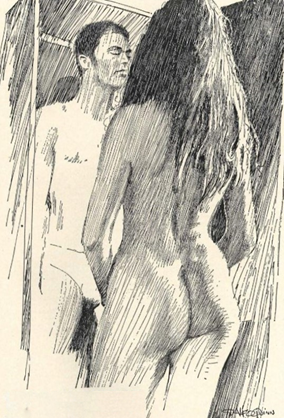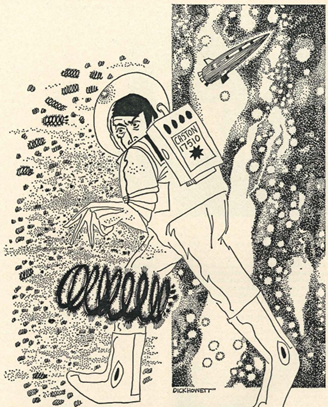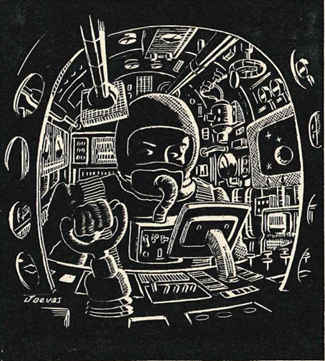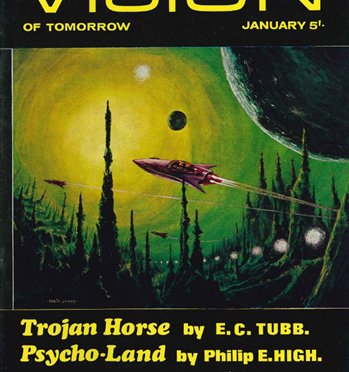
By Mx Kris Vyas-Myall

Just some of the many brands of sex you can enjoy at your local tobacconist theatre
It seems the final death knell for Capital Punishment in the UK will be sounded soon. There is a vote soon in the House of Lords, widely expected to pass, to make the trial period for the abolition of the death penalty permanent. Over the last few years we have seen a raft of reforms, removing Victorian laws and decriminalizing a number of controversial practices. At the same time, censorship is being removed so you can see nudity on the West End or watch young women discussing sex in the cinema. This would seem to be placing Britain into a more permissive society.

“Sandwiches, blimey! Whatever did I give the wife?” – Monty Python’s Flying Circus
But that does not seem to be true in all areas. The crackdown on the use of illicit drugs continues apace, with heavy-handed tactics of the police being widely reported. Meanwhile, the Northern Irish MP Bernadette Devlin is currently appealing against a six-month sentence of “inciting persons unknown to commit the offence of riotous behavior” for encouraging resistance to police during the so-called Battle of the Bogside.
As such, it appears this liberalism has its limits. Actors can get their kit off in front of the public but not smoke cannabis in their own homes. Women can get access to the contraceptive pill and abortions (assuming their GP agrees) but they still cannot get a mortgage without a male guarantor. People from more different backgrounds are becoming MPs but political activity outside of official parameters is still viewed with suspicion.
This sense I have of British society also reflects what I am seeing in Visions of Tomorrow. It seems to be throwing off some of its earlier conservatism but has not become a second New Worlds either. Instead, the contents of this issue would not be out of place in Dangerous Visions.

Cover illustration by Eddie Jones
Now back on its regular monthly schedule, the editor gives us an incredibly dull introduction, discussing whether SF has become a mainstream genre. No more insight is given than the hundred other editorials on the subject for the past 30 years.
The Ill Wind by Jack Wodhams

Illustrated by Dick Howett
Gongi Wackerman stinks and has been going through many experiments to see if he can be rid of his noxious odour. However, one such test concludes his scent has a psychedelic effect on people and they want to employ him to help mental patients.
Wodhams is not an author I have particularly enjoyed in the past and this continues that trend. It is so silly and dull, it makes his Undercover Weapon, seem like a work of high literature.
One star, only because I can’t go any lower.
Trojan Horse by E. C. Tubb

G. Alfo Quinn gives us an illustration that seems more at home in New Worlds
In the future, laws and self-censorship have been abolished. People are free to act on their own choices. Even murder is allowed, but classes are taught to ensure that people are smart with their actions as a means of self-defence.
Marlo French is contacted by Ed Whalen, High Boss of Chicago Chemicals. Whalen’s daughter Naomi has stolen their new compound and is hiding out in the impenetrable Staysafe Apartments. As a discreet freelancer, French is tasked with getting back the pills by any means necessary.
Marlo discovers that Naomi has a penchant for Mannikins, robotic male blow-up dolls, and so proposes to impersonate one in order to get inside her flat. But this case may not be as simple as he believes.
This is a much darker and more complicated tale than I expected from these pages or Ol’ Edwin. He posits a world without laws or morality but makes it feel real and vivid, not a cardboard cutout for a simple point. The case itself has a great atmosphere and consists of the kind of twists and double-crosses you would expect from hard-boiled detective fiction. I hope we get more exploration of this future, as it is more fascinating to me than Raynolds’ People’s Capitalism or Anderson’s space navy tales.
I am not sure if he is getting better, or if I am getting more tolerant as I age through my thirties, but I found this to be his second exemplary tale in as many months.
A High Four Stars
Ward 13: A Tale of the first Martian by Sydney J. Bounds

Illustrated by Dick Howett
In City Seven Hospital, Dr. Kirby is part of a team that collects on scene organ donations before they are stolen by illegal freeze-wagons. One night, on his way home, he finds one of his nurses under attack by a gang. In attempting to rescue her, he is kidnapped and put to a surprising purpose.
I don’t think it was just me grooving to a Zappa record that meant I had trouble concentrating, I found it over-described and dull. Also these kind of panicky stories about organ transplants and population explosions have become so common they already feel more cliched than ray guns and flying saucers.
A moderately interesting twist in the tail keeps it just off the bottom rating.
A Low Two Stars
Breeding Ground by Christopher Priest

Illustrated by Dick Howett
Luke Caston, a space salvager, comes across the wreck of the Merchant Princess, a lost ship fabled to carry tons of gems. However, the ship is infested with Space-Mites, three-inch hairy coils that reproduce at an extraordinary rate when they find a source of electrical energy. They also happen to be Caston’s biggest fear.
A reasonable story, reasonably told. Not revolutionary but atmospheric and enjoyable.
Three Stars
Trieste: SF Film Festival by John Carnell
Whilst much of the rest of the SF community were eagerly watching the Apollo 11 mission in July, the New Writings editor John Carnell was attending an SF film festival in Trieste, Italy. The award winners were as follows:
Best Film: The Last Man (France)
Best Actress: Taja Markus – The Time of Roses (Finland)*
Best Actor: Tobias Engel – You Imagine Robinson (France)
Animated Short Film: Cosmic Zoom (Canada)
Others he calls out of note include The Illustrated Man, Mr. Freedom and Windows of Time, whilst pouring scorn on the British entry The Body Stealers and giving a mixed review of an Italian adaptation of The Tunnel Under The World.
An interesting look at films that might otherwise pass us by. I will certainly be keeping my eyes peeled for showings at the BFI.
Four Stars
*Luna fanzine gives the winner as a different actress from the same film, Ritva Vespa. I have not been able to ascertain which report is accurate.
The Impatient Dreamers 4: Science Fiction Weakly by Walter Gillings

Reproduction of a cover from Britain’s short-lived attempt to get into the SF game. Artist unknown.
The recitations of Gillings’ memories of SF yesteryear reaches 1934. He tells us of the short-lived weekly magazine Scoops, his own early attempts to get an SF magazine off the ground, and serialisations of Burroughs and Conan-Doyle.
By this point you know what to expect from Gillings, and this untold history continues to impress me.
Five Stars
Time-Slip by Eric Harris

Illustrated by Dick Howett
Constable Paul goes with an Arunta tracker called Nungajiri to try to find a family lost in the outback. Whilst four of the party are found, the baby remains unaccounted for. Even though the rest of the police think he is crazy, Paul and Nungajiri are determined to see if they can bring the child home.
This is a strange kind of tale. It starts of as a standard mystery story and evolves into one involving geometry, nodal-points in the timestream and the concept of Dreamtime. It felt to me like a cross between Picnic at Hanging Rock and an early HP Lovecraft story. One that I am not sure I understood but I am pretty sure I am not supposed to either.
I am afraid I am not particularly familiar with depictions of aboriginal Australians (having never visited the country myself and I have no familiarity with the Arunta religion) and as such I do not feel particularly qualified to comment on it. I will say this felt somewhat cliched to me but not meanspirited, although that is only a personal sense.
A tentative Four Stars, at least until someone with more knowledge than me can fill in the gaps.
Psycho-Land by Philip E. High

Illustrated by Dick Howett
Peter Carton, a sufferer of dementia praecox, has taken control of a machine that makes people in range subject to paranoia and irrational anger. With thirty thousand lives in jeopardy, the government is forced to call on William Charles Hopwood, a noble prize-winning physicist and ardent pacifist, as possibly the only person qualified to both resist the impulses and turn off the machine.
Devices affecting brain waves have become a common feature of SF recently, but this manages to elevate itself above the pack in a few different ways. Firstly, the atmosphere. As it indeed says in the text, High makes a small city seem like an alien world. Secondly, pacificists rarely have an active role in SF stories, so it was fascinating to see how this concept could be used. Finally, the twist in the tail is a good one, I will be thinking about it for some time.
A High Four Stars
Takeover by Harold G. Nye

Illustrated by Eddie Jones
Charlie Adams is a grumpy hypochondriac who finds himself in the midst of a plan by television sets to destroy humanity.
I am reliably informed this is a pseudonym of Lee Harding, an unprolific but solid writer. As a piece of satire on modern society and religion it is more subjective than most pieces. The silliness didn’t land for me but may appeal more to others.
Two Stars
Prime Order by Peter Cave

Illustrated by Dick Howett
On a routine mining expedition, one of the team caught space fever and then proceeded to murder the crew and destroy the ship. In order to avoid another such incident, Martin Stone at Amalgamated Electronics is asked to design one of the most intelligent and powerful robots ever. It also has one significant difference to all prior models. Asimov’s first law of robotics:
A robot may not injure a human being or, through inaction, allow a human being to come to harm.
Is replaced with:
The Robot must be able to protect the majority of the party at all or any cost.
The result is Robot R.E.D. 197, who appears to work perfectly in testing. However, when he and a mining crew crash land on an uncharted planet, his logic circuits are pushed to their limit.
At first glance this seems a more traditional tale that would fit snugly into Analog’s pages. However, it is lifted up by the cynicism of the people involved and the darkness of the ending.
A high three stars
Fantasy Review

Illustration by Jeeves
Ken Slater reviews John Brunner’s Quicksand, which he highly recommends, Peter Weston raves about Larry Niven’s collection Neutron Star and Kathryn Buckley praises Anne McCaffrey’s Dragonflight (with the caveat of allowances for being a newcomer to novels). Meanwhile, John Foyster has mixed feelings about the contents of Carr & Wollheim’s latest World’s Best SF, Vonnegut’s Slaughterhouse-Five and the multi-authored Conan of Cimmeria, but is full of praise for Harry Warner, Jr.’s All Our Yesterdays.
A New Era?

Preview illustration by Eddie Jones for next month’s short novel, Life of the Party
So, this marks a slight change of direction for Vision of Tomorrow. Gone are the Kenneth Bulmer swashbucklers—in their place are atmospheric tales of ambiguous morality. The kind of pieces Harlan Ellison would probably be happy with.
Whether this trend continues or reverses into the 70s will probably be a reflection of where British society heads. On the one hand, all the recent court cases and laws on censorship have been on the side of more liberality. On the other, there are prominent voices that decry the current obsession with “pills and pot” in the media.

Last night, BBC2 went with more traditional fare: This Happy Breed to celebrate Noel Coward's 70th Birthday
Anyway, there will be many years ahead to worry about that. For now, I wish you all the joy of the season and, if I don't see you sooner, a happy new year!
[New to the Journey? Read this for a brief introduction!]



